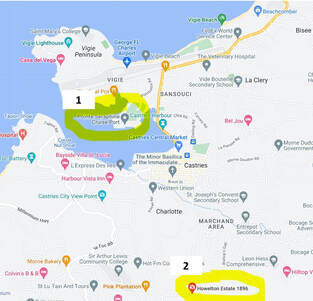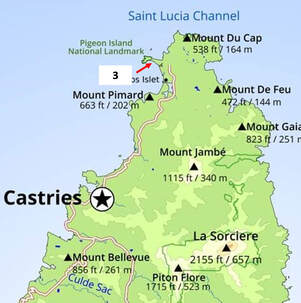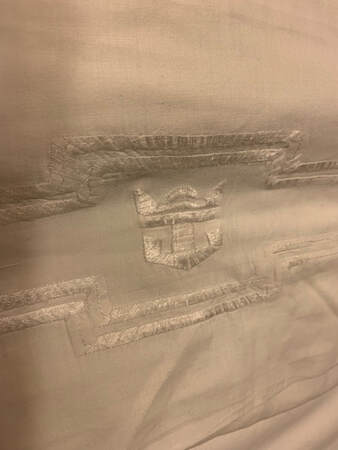Day 06 2/16 - Saint Lucia
We arrived at the island of Saint Lucia. It is thrilling to come into port at a new place - a place I've never seen before. Saint Lucia looks inviting.
I love the breakfast in the Main Dining Room. When I dine alone I read Dashiell Hammett - starting with The Continental Op, a collection of short stories. Hammett's work defines the femme fatale.
I love the breakfast in the Main Dining Room. When I dine alone I read Dashiell Hammett - starting with The Continental Op, a collection of short stories. Hammett's work defines the femme fatale.
After a leisurely meal, I went down to the clinic to have them look at my injuries again, a follow-up visit. My knee has developed a quarter sized bruise and I have some swelling. I am developing a rash along the edge of the knee brace.
Using my walking stick, I am okay to go on an excursion. Yesterday, I swapped my Santa Lucia excursion for one with less walking. No "Open Fun Bus - Scenic and Beach" for me. This new excursion is later in the day and will not depart from the theater . . . I just go down to the dock . . .
Using my walking stick, I am okay to go on an excursion. Yesterday, I swapped my Santa Lucia excursion for one with less walking. No "Open Fun Bus - Scenic and Beach" for me. This new excursion is later in the day and will not depart from the theater . . . I just go down to the dock . . .
Today is a good day to relax in my room and read. I brought several books with me. I read a favorite children's fiction series about the Melendy family in my room. I read noir when I'm out of the room.
The Windjammer Cafe is a beautiful place to have a little bite to eat before going on an excursion. Today I am going to see the local sites and some local industry: Batik.
Getting to the dock required me to walk down a four story ramp. (!) It offered a lovely view of the cruise ship port area.
Leaving the dock, we drove through the capital, Castiries. The island was in the midst of celebrating independence so there were lots of flags and decorations in the national flag colors.
Most of the excursion was riding around in a bus. Below is a slideshow of the first part . . . I've included all of it, including shots with people's heads in the way and my finger covering part of the photo - and sped up the rate - so that it might be like what it felt like and looked like as I traveled on a tour bus through Saint Lucia up into the hills to the first stop.
Vendors set up booths in parks and other open spaces. These were organized affairs with lots of clothes, hats, handmade items, knickknacks, and all kinds of things. There were also many vendors along the city streets and suburban roads, selling bottled beverages, snacks, and produce.
Our drive took us up into the hills, with each curve in the road unfurling to reveal another panoramic view. At one point the bus slowed down so we could take pictures of . . . our cruise ship.
I tried to capture the architecture that caught my eye. The colors were brighter than one sees in the US. There is a particular kind of banister and porch railing that is quite popular. We saw the governor's mansion, with golden lions on the entrance gate. There were no guards and no concertina wire. There were many fine schools at every level of education.
It was an interesting drive but the roads were a bit winding for me; finally we reached our first destination, the Howelton Estate, established in 1896.
Vendors set up booths in parks and other open spaces. These were organized affairs with lots of clothes, hats, handmade items, knickknacks, and all kinds of things. There were also many vendors along the city streets and suburban roads, selling bottled beverages, snacks, and produce.
Our drive took us up into the hills, with each curve in the road unfurling to reveal another panoramic view. At one point the bus slowed down so we could take pictures of . . . our cruise ship.
I tried to capture the architecture that caught my eye. The colors were brighter than one sees in the US. There is a particular kind of banister and porch railing that is quite popular. We saw the governor's mansion, with golden lions on the entrance gate. There were no guards and no concertina wire. There were many fine schools at every level of education.
It was an interesting drive but the roads were a bit winding for me; finally we reached our first destination, the Howelton Estate, established in 1896.
Excursion by bus, heading south from the port
At the Howelton Estate of the excursion there were some really grand views. A woman explained the batik process to us . . . but we did not see a demonstration of the process. I was disappointed.
I bought a bottle of water to help support the venue. Then I found the gift shop. As is often the case, I liked the gift shop better than the venue. There was not enough time to explore it properly and see the examples of batik created at this shop, but I did find a cool apron that was made on-island and a little pouch that was probably not. One of my goals in visiting the islands is to spend money there.
I think of myself, as a tourist in a foreign land, as a form of colonial force, bring the cultural norms of my homeland, norms I have sought to evade all my life, to a place that doesn't need our winners and losers mentality. Also I can get some tropical breezes. So I feel it is my duty, at the very least, to spend money.
To me the situation is analogous to the role of salmon in the mountains. They start out as fingerlings, a fish the size of your finger. This fish leaves the place of its birth and travels hundreds of miles to the sea where it grows fat on fish, crustaceans, and krill. Then the salmon hears its mama's voice calling it home . . . er then the salmon struggles for weeks, working its way upstream back to its birthplace were it mates and dies. But what has happened here, ecologically, is that the salmon has departed the region with the mass of a pencil and returned with a mass of a bowling ball. This nutrition was collected in the ocean and delivered to high in the mountains, providing dinner in the chain of life after having sex and kicking the bucket.
So I, the tourist, am delivering the nutrition, just like the salmon. Therefore, I bought stuff.
I bought a bottle of water to help support the venue. Then I found the gift shop. As is often the case, I liked the gift shop better than the venue. There was not enough time to explore it properly and see the examples of batik created at this shop, but I did find a cool apron that was made on-island and a little pouch that was probably not. One of my goals in visiting the islands is to spend money there.
I think of myself, as a tourist in a foreign land, as a form of colonial force, bring the cultural norms of my homeland, norms I have sought to evade all my life, to a place that doesn't need our winners and losers mentality. Also I can get some tropical breezes. So I feel it is my duty, at the very least, to spend money.
To me the situation is analogous to the role of salmon in the mountains. They start out as fingerlings, a fish the size of your finger. This fish leaves the place of its birth and travels hundreds of miles to the sea where it grows fat on fish, crustaceans, and krill. Then the salmon hears its mama's voice calling it home . . . er then the salmon struggles for weeks, working its way upstream back to its birthplace were it mates and dies. But what has happened here, ecologically, is that the salmon has departed the region with the mass of a pencil and returned with a mass of a bowling ball. This nutrition was collected in the ocean and delivered to high in the mountains, providing dinner in the chain of life after having sex and kicking the bucket.
So I, the tourist, am delivering the nutrition, just like the salmon. Therefore, I bought stuff.
Then we drove across to the other side of the island. The slide show (below) is all the photos I took between the Howelton Estate and Pigeon Point - the good, the bad, the ugly - crooked shots, shots with my hand in the way, shots with reflections, blurry shots . . . but I like it - it captures riding in a tour bus (van?) on Saint Lucia. There is a good shot of bananas and another of a popular fruit or nut - was it mango? was it almond? I didn't take notes in a moving vehicle.
I am always interested in the disparity between wealth and poverty, everywhere I go, and Saint Lucia was a case study. I got some photos of some poor looking homes, which were not in one district but were embedded into the neighborhoods of mostly well kept houses.
There must have been elite enclaves somewhere on the island, but I did not see them, except for the yacht harbor. I found it shocking that unlike Saint Croix, where the large mangrove swamp was respected for its ecological value, on Saint Lucia they tore up the huge mangrove swamp to put in a closed access yacht harbor. And what did they do with the debris? They used it to build a causeway to Pigeon Island - which is now Pigeon Point. I imagine it must have seriously disturbed the ecology of the region to destroy the confluence of the Caribbean Sea and the Atlantic Ocean, but our tour guide mentioned none of this.
The tour guide did share a couple of interesting things. One was that houses under construction were taxed at a reduced rate and thus many homes were under constant construction and that putting a house on stilts with plans for completing the space beneath was one way to circumvent property tax. I looked it up on the internet and could find no support for this, and other explanations for houses on stilts in the Caribbean were that it keeps the home more secure from creepy crawly things and the that it helps keep the house cooler, ventilating it from below. But that was his story, and I'll bet he's not making it up.
The other thing he talked about was the popularity of thoroughbred horses on the islands. He said that people of modest means owned horses and staked them on vacant land for grazing. He had a horse when he was young, but it broke its tether and was hit by a car. He was excited for the prospect of a horse racing track that was being built and felt that it would be a good thing for the island - and he was a thoroughbred horse enthusiast. We saw horses as he described and there was a horse with riders at Pigeon Point.
Here is a link to an article that I found about the new race track.
I am always interested in the disparity between wealth and poverty, everywhere I go, and Saint Lucia was a case study. I got some photos of some poor looking homes, which were not in one district but were embedded into the neighborhoods of mostly well kept houses.
There must have been elite enclaves somewhere on the island, but I did not see them, except for the yacht harbor. I found it shocking that unlike Saint Croix, where the large mangrove swamp was respected for its ecological value, on Saint Lucia they tore up the huge mangrove swamp to put in a closed access yacht harbor. And what did they do with the debris? They used it to build a causeway to Pigeon Island - which is now Pigeon Point. I imagine it must have seriously disturbed the ecology of the region to destroy the confluence of the Caribbean Sea and the Atlantic Ocean, but our tour guide mentioned none of this.
The tour guide did share a couple of interesting things. One was that houses under construction were taxed at a reduced rate and thus many homes were under constant construction and that putting a house on stilts with plans for completing the space beneath was one way to circumvent property tax. I looked it up on the internet and could find no support for this, and other explanations for houses on stilts in the Caribbean were that it keeps the home more secure from creepy crawly things and the that it helps keep the house cooler, ventilating it from below. But that was his story, and I'll bet he's not making it up.
The other thing he talked about was the popularity of thoroughbred horses on the islands. He said that people of modest means owned horses and staked them on vacant land for grazing. He had a horse when he was young, but it broke its tether and was hit by a car. He was excited for the prospect of a horse racing track that was being built and felt that it would be a good thing for the island - and he was a thoroughbred horse enthusiast. We saw horses as he described and there was a horse with riders at Pigeon Point.
Here is a link to an article that I found about the new race track.
We had a short stop at the entrance to Pigeon Point; I beelined it to the bathroom and got right in. When I left there was a long line. Women's bathroom lines are always ten times longer (or infinity times longer) than men's bathroom lines. It cost a dollar to use the restroom and there was a woman seated at the door to take the money. Bathrooms at public places, such as the shopping mall at the port entrance, and public parks, had attendants who kept the place clean. I tipped them all; it was probably their only income for the job.
It was interesting to stand at a point where I could see both the Caribbean Sea and the Atlantic Ocean just by turning around:
It was interesting to stand at a point where I could see both the Caribbean Sea and the Atlantic Ocean just by turning around:
Driving along the causeway en route to the ship, I enjoyed this view of the Atlantic Ocean:
Traveling back to the ship, through Castries, driving on the wrong side of the road!
Got back to my cabin; found THIS on the bed. Looks scary. What IS it? Please note: I brought my own pillows . . . that is MY pillow case behind the towel-origami dog? gargoyle? monster?
The sheets are monogrammed with the Royal Caribbean logo. They are VERY luxurious.
Tomorrow - Barbados!














